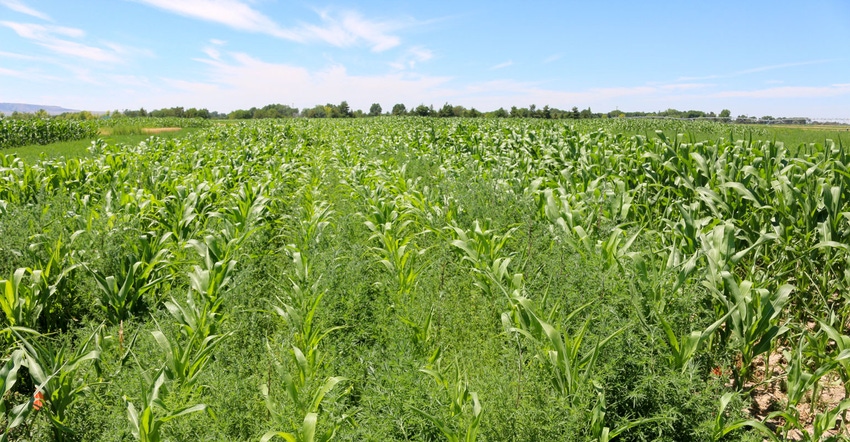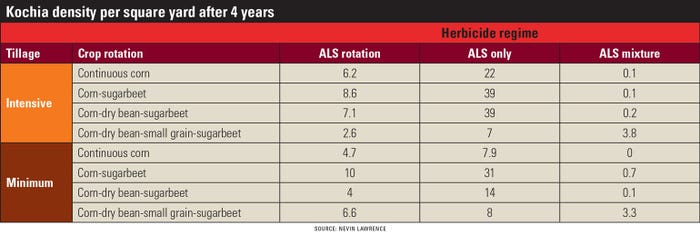April 12, 2021

Kochia remains one of the most challenging weeds to control in western Nebraska. Kochia can be resistant to Group 5 (atrazine), Group 2 (imazamox), Group 9 (glyphosate) and Group 4 (dicamba) herbicides in western Nebraska.
While there are still many herbicides available to irrigated corn growers, those who grow dry beans and sugarbeets have few options because of crop rotation restrictions. When a grower runs out of herbicide options, what can they do?
IWM to the rescue
Integrated weed management is often discussed as the solution. A simple definition of IWM is the strategic use of all the tools a farmer has available, including herbicides, tillage, crop selection, crop rotation, cover crops and other cultural practices.
Does IWM actually work? In 2014, a study was established in Scottsbluff, Neb., to find out. The study ran for four years, concluding in 2017. The goal of this study was to use IWM to target kochia in an irrigated crop rotation.
Each site was established by seeding a mix of kochia biotypes of which 95% were susceptible to Group 2 (ALS-inhibiting herbicides) and 5% were resistant to Group 2 herbicides. The seed mixture used created a “low level” of resistance in the seed bank, which simulates the early stages of herbicide-resistance development.
3 strategies
There were three IWM strategies, including the use of tillage, crop rotation and herbicide strategy. The tillage strategy used two different treatments — minimal tillage or intensive tillage.
Four crop rotations were established — four years of continuous corn; a corn-sugarbeet-corn-sugarbeet rotation; a corn-sugarbeet-corn-dry bean rotation; and finally, a small grain-sugarbeet-corn-dry bean rotation.
The final strategy was herbicide use, with three different treatments. This included a Group 2 herbicide-only treatment, where only herbicides that wouldn’t control the resistant kochia were applied every single year.

The last treatment was mixing MOAs, where an effective herbicide treatment was mixed with a Group 2 herbicide each year. For the rotation herbicide treatment, in 2014 and 2016, the alternative herbicide was used, and in 2015 and 2017, the Group 2 herbicide was used.
Results are in
After four years, kochia density ranged from as low as 0 to 40 kochia plants per square yard, with seed production as high as 8,000 seeds per square yard. Yield reduction was significant — sugarbeet and dry bean plots experienced total yield loss, and corn yield was reduced from 200 to 60 bushels per acre from the highest kochia densities. Wheat, however, was not greatly affected by kochia competition, always yielding between 55 to 60 bushels.
So, what worked in reducing kochia numbers over four years? The obvious winner was using herbicide mixtures, with low kochia density observed regardless of tillage system or crop rotation.
But what if good herbicides are not available? Including wheat in the rotation helped tremendously, even when an ALS herbicide was used every year. In the sugarbeet-corn and sugarbeet-corn-dry bean rotation, kochia density was reduced from near 40 plants every square yard down to only seven, even when using an herbicide that didn’t work.
Wheat, in irrigated systems, is great at reducing kochia emergence early in the season. Although this study didn’t consider wheat as a cover crop, a similar benefit may be observed by using any small grain — wheat, barley, oats, rye or triticale — as a cover crop preceding other crops. Small grains close rows quickly and smother early plants before they have a chance to emerge in the spring.
Lawrence is a Nebraska Extension weed management specialist.
About the Author(s)
You May Also Like




